Lab 5 - Palate, Oral Cavity, Larynx Flashcards
Which muscle is labeled by #1?
What is its action?

Aryepiglottic muscle
Pulls the epiglottis posteriorly to help close the larynx - opposes the thyroepiglottic muscle
(Restricts the opening like a purse string, but doesn’t close it completely)

Which structure is labeled by #5?
What is its action?

Cricothyroid muscle
Phonation - Tilts the thyroid forward to tense the vocal cords -> higher pitches
Innervated by the external laryngeal nerve

Which structure is labeled by #7?

Hypoglossal nerve (CN XII)
- Inferior to the lingual and glossopharyngeal nerves
- Lingual from CN V3, labeled #2 here
- Glossopharyngeal CN IX, labled #4 here

The only pre-ganglionic sympathetic that joins a branch of the trigeminal nerve joins the ___________ nerve and then synapses in the ___________ ganglion
The only pre-ganglionic sympathetic that joins a branch of the trigeminal nerve joins the mandibular** nerve and then synapses in the **submandibular ganglion
Which structure is labeled by #7?

Cricothyroid ligament

Which structure is labeled by #7?

Cricoid cartilage
(Also #9)

Which nerve and artery are labeled by #1?

Greater palatine nerve and artery
(Extends anteriorly, vs. lesser palatine which extend posteriorly)

Which muscle abducts the vocal cords to open the airway?

5 - posterior cricoarytenoid

Which muscle is labeled by #2?
What is its function?

Genioglossus
-
Protrude the tonuge
- The only muscle that protrudes the tongue!
- Deviate the tongue to the opposite side
- Depress the tongue

Which structure is labeled by #7?

Internal carotid artery
(Also #10)

Which structure is labeled by #3?

Geniohyoid

Which structure is labeled by #13?

Epiglottis

What structures serve as the posterior boundary of the oral cavity?
Sulcus terminalis (#4)
Palatoglossal arches (#5)

Which structure is labeled by #4?

Levator palati
(aka levator palatini)

Which structure is labeled by #8?

Apex of the tongue

Which structure is labeled by #9?

Cricoid cartilage
(Also #7)
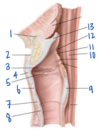
Which structure is labeled by #6?

Eustachian tube
(Also #9)

Which structure is labeled by #3?

Lateral cricoarytenoid muscles
(Adduct/close the vocal cords)

Which structure is labeled by #3?

Styloglossus muscle

Which structure is labeled by #5?
What is its action?

Posterior cricoarytenoid muscle
Abducts vocal cords -> opens airway

Which muscle is labeled by #3?
What is its function?

Hyoglossus
Retract the tongue

Which structure is labeled by #6?
What is its action?

Recurrent laryngeal nerve
- Motor innervation to laryngeal muscles except cricothyroid muscle
- Visceral sensory below vocal cords
(Internal laryngeal nerve is visceral sensory above vocal cords, external laryngeal is motor to the cricothyroid muscle)
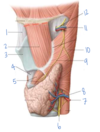
Which structures are labeled by #6?

Deep lingual artery and vein

Which fold is labeled by #2?
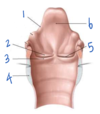
Vestibular fold (aka false vocal fold)
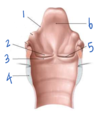
Which structure is labeled by #4?
What is its action?

Posterior cricoarytenoid
Abducts (opens) the vocal cords

Which structure is labeled by #10?
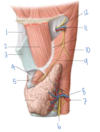
Inferior pharyngeal constrictor
(Can tell because it attaches to the thyroid and cricothyroid cartilages)
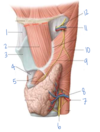
Which muscle is labeled by #3?

Posterior cricoarytenoid

Which structure is labeled by #8?
(Bone and part)

Inferior horn of the thyroid cartilage

Which structure is labeled by #2?
What is its function?

Lateral cricoarytenoid muscle
Adducts vocal cords -> shortening and relaxation -> higher pitch
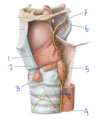
Which structure is labeled by #8?

Lingual artery
Branch of external carotid

Which structure is labeled by #4?
What does it innervate?
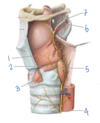
Recurrent laryngeal nerve
Visceral sensory to the larynx below the vocal cords
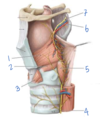
Which structure is labeled by #4?

Hyoid bone

Which structure is labeled by #5?

Pterygoid process
(Medial and lateral pterygoid plates)

Which space is labeled by #5?
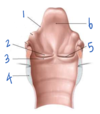
Ventricle
The space between the vestibular/false vocal fold (#2) and the vocal/true vocal fold (#3)

Which structure is labeled by #6?

Cricoid cartilage

Which structure is labeled by #3?

Lingual nerve
(Branch of mandibular nerve, CN V3)

Which fold is labeled by #1?
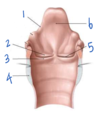
Aryepiglottic fold

Which structure is labeled by #9?

Submandibular duct

Which structure is labeled by #1?

Muscular process of arytenoid cartilage
The attachment points for the lateral and posterior cricoarytenoid muscles

Which structure is labeled by #1?
(Bone and part)

Lesser horn of the hyoid bone
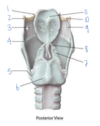
Which structure is labeled by #2?
(Bone and part)

Lesser horn of the hyoid

Which structure is labeled by #5?

Uvula

Which structure is labeled by #8?
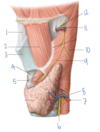
Middle thyroid vein

Which structure is labeled by #7?

Anterior lingual gland

Which structure is labeled by #4?

Glossopharyngeal nerve (CN IX)
- As far as the tonuge goes, CN IX will provide taste to the posterior 1/3 of the tongue
- Deep and lateral to the styloglossus muscle (#3 in this image)

Which structure is labeled by #8?

Palatopharyngeal arch
Overlies the palatopharyngeal muscle

Which structure is labeled by #4?

Cricoid cartilage

Which structure is labeled by #3?
What is its action?

Transverse arytenoid
Abducts (closes) the vocal cords - not active during whisper

Which structure is labeled by #7?

Palatopharyngeal fold ovlerlying the palatopharyngeal muscle
Note - the palatoglossal pharyngeal fold/musle is anterior (#1)

Which structure is labeled by #5?

Lingual nerve
Spirals under the submandibular duct
The hypoglossal nerve enters the tongue deeper and more posteriorly to innervate the tongue muscles

Which structure is labeled by #1?
What is its function?

Thyroarytenoid muscle
Shortens and adducts the vocal folds

Which structure is labeled by #2?

Thyrohyoid muscle

Which structure is labeled by #5?
(Cartilage and part)

Laryngeal prominence of the thyroid cartilage

Which structure is labeled by #6?

Palatine tonsil

Which structure is labeled by #9?

Thyroid cartilage

Which structure is labeled by #12?
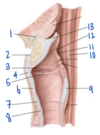
Piriform recess
(Food might get stuck here - it is an artifact of the convexity of the cricoid cartilage)

Which structure is labeled by #11?

Superior laryngeal artery and vein

Which structure is labeled by #6?

Thyroarytenoid muscle
(Pulls the thyroid cartilage back and up to put slack in the vocal cords and lower the pitch of the voice)

Which structure is labeled by #1?

Hyoid bone

Which structure is labeled by #10?

Hyoid bone

Which structure is labeled by #4?
(Cartilage and part)
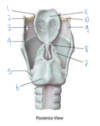
Superior horn of thyroid cartilage

Which structure is labeled by #6?
Which nerves come together here?

Submandibular ganglion
- Lingual nerve - branch of CN V3, labeled #2 here
- Corda tympani - branch of CN VII
- Taste to anterior 2/3 of tongue, parasympathetics
- Sympathetic branches

What goes through the foramen labeled by #9?

Internal laryngeal nerve, superior laryngeal artery, and vein
The internal laryngeal nerve is the branch of the superior laryngeal nerve that provides visceral sensory information to the larynx above the vocal cords

Which structure is labeled by #9?
What does it innervate?

Superior laryngeal nerve (external branch)
Motor to the cricothyroid muscle -> higher pitches in phonation
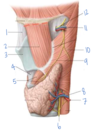
Which structure is labeled by #9?

Epiglottis

Which structure is labeled by #5?

Cricoid cartilage
The only cartilage ring that completely encircles the trachea

Which structure is labeled by #1?
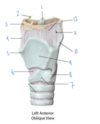
Epiglottis

Which structure is labeled by #2?

Mylohyoid muscle

Which structure is labeled by #2?

Lingual nerve (from CN V3)
- Recall that parasympathetic and special sensory neurons from CN VII (via corda tympani), and sympathetics, follow the lingual nerve to the anterior 2/3 of the tongue
- Note that the lingual nerve is lateral and superficial to the glossopharyngeal nerve (CN IX, labeled #4 here)

Which structure is labeled by #5?

Vocal fold
(True vocal fold)

Which structure is labeled by #7?

Superior laryngeal nerve, internal brance
Has already entered throught the thyrhyoid membrane

Which structure is labeled by #3?
What is its function?

Cricothyroid muscle
Lengthens and alters tension in vocal cords -> deeper pitches
Note: the only intrinsic laryngeal muscle innervated by the external laryngeal nerve (from superior laryngeal nerve)
All others are innervated by the reccurent (inferior) laryngeal nerve

Which structure is labeled by #10?

Opening of the eustachian tube

Which structure is labeled by #4?

Cricothyroid membrane
(Site of the high emergency airway)

Which space transmits the nasopalatine nerve into the oral cavity?
Incisive foramen

Which structure is labeled by #11?

Genioglossus muscle
(The only one that protrudes the tongue!)

Which structure is labeled by #5?

Lingual artery
Branch of external carotid

Which structure is labeled by #8?

Palatine tonsil
(The “classic” tonsil)

Which structure is labeled by #3?
(The opening, difficult to see)

Sublingual papilla
Opening of the duct of the submandibular salivary gland

Which structure is labeled by #11?
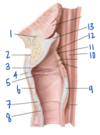
Aryepiglottic fold
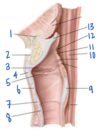
Which fold is labeled by #6?

Epiglottis

Which structure is labeled by #4?

Inferior alveolar nerve
(Branch of mandibular nerve, CN V3)

Which structure is labeled by #11?

Epiglottic cartilage

Which structure is labeled by #12?

Greater horn of the hyoid bone

Which structure is labeled by #2?

Oblique arytenoid

Which structure is labeled by #4?

Submandibular duct
Carries secretions from the submandibular salivary gland to the sublingual papilla, where they are excreted

Which structure is labeled by #8?

Corniculate cartilage

Which structures are labeled by #1?
Do they have tastebuds?

Filiform papillae
- Keratinized layer of tongue epithelium, give the tonuge its texture
- No tastebuds

Which structure is labeled by #9?

Eustachian tube
(Also #6)

Which structure is labeled by #10?

Hyoid bone

Which structure is labeled by #1?

Superior meatus
Drains the posterior ethmoid air cells

Which structure is labeled by #2?
Does it have taste buds?

Vallate papilla
Yes! Has tastebuds

Which structure is labeled by #9?

Lingual vein
Drains into internal jugular

Which structure is labeled by #3?

Tensor palati
(Aka tensor palatini)

Which artery and nerve are labeled by #4?

Lesser palatine nerve and artery
(Extend posteriorly, vs. greater palatine nerve and artery which extend anteriorly)
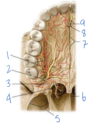
Which muscle is labeled by #1?
What is its function?

Styloglossus
Retracts the tongue

Which structure is labeled by #1?

Geniohyoid muscle
Inferior to genioglossus (#11)

Which structure is labeled by #2?

Thyrohyoid ligament
(pretty sure ligament and membrane are kind of interchangeable? maybe the ligament is midline?)
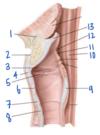
Which structure is labeled by #3?

Transverse and oblique cricoarytenoid muscles
(Adduct/close the vocal cords)

Which structure is labeled by #5?
(Cartilage and part)

Inferior horn of thyroid cartilage

Which structure is labeled by #7?

Vocalis muscle
(The upper part of the thyroarytenoid)

Which structure is labeled by #1?

Palatoglossal fold - overlies the palatoglossus muscles
Note - the palatopharyngeal fold and msucle (#7) is posterior to the palatoglossal fold/muscle

Which structure is labeled by #3?

Vestibular fold
(aka false vocal fold)
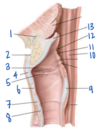
Which structure is labled by #5?

Cricothyroid muscle
(Pulls the thyroid cartilage down and forward to stretch the vocal cords and raise the pitch of the voice)

Which structure is labeled by #6?

Vomer

Which structure is labeled by #5?

Palatoglossal arch
(Overlies teh palatoglossal muscle)

Which structure is labeled by #3?

Thyrohyoid membrane
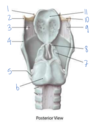
Which structure is labeled by #10?

Sublingual duct

Which structure is labeled by #8?

Internal jugular vein

Which structure is labeled by #4?

Thyrohyoid ligament

List the 3 kinds of papillae of the tongue
Which have tastebuds?
- Filiform (#1)
- No tastebuds
- Part of the keratinized epithelium of the tongue
- Vallate (#2)
- Has tastebuds
- Largest
- Fungiform (#3)
- Has tastebuds
- Mushroom-shaped

What nerve enters the larynx through the foramen labeled by #11?
What does it innervate?
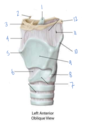
Internal laryngeal nerve
Visceral sensory to the larynx above the vocal cords
(Branch of the superior laryngeal nerve, which is a branch of the vagus nerve CN X)

Which structure is labeled by #2?
(Bone and part)
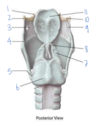
Greater horn of the hyoid bone
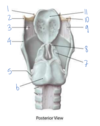
Which structure is labeled by #6?

Stylohyoid muscle

Which structure is labeled by #10?

Internal carotid artery
(Also #7)

Which structure is labeled by #2?

Sublingual fold
(aka Plica sublingualis)

Which structure is labeled by #11?

Pharyngeal tonsil
(aka adenoid)

Which structure is labeled by #8?

Cricoid cartilage
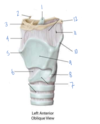
Which structure is labeled by #6?
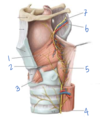
Superior larygneal vein and artery

Which muscle is labeled by #4?

Cricothyroid
(Hard to tell bc its cut, but remember that it is superficial to the posterior and lateral cricoarytenoids)

Which structure is labeled by #2?

Genioglossus
Note - the only muscle that protrudes the tongue!

Which structure is labeled by #5?
What is its action?

Cricothyroid
Pulls the thyroid cartilage forward and down - stretches the vocal cords -> higher pitch

Which structure is labeled by #2?

Posterior cricoarytenoid muscle
(Abducts vocal cords)

Which structure is labeled by #7?
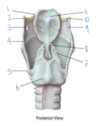
Arytenoid cartilage
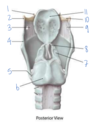
Which structure is labeled by #10?

Lingual tonsil

Which structure is labeled by #7?

Hyoglossus muscle

Which structure is labeled by #1?

Frenulum of the tongue

Which structure is labeled by #6?

Epiglottis

Which structure is labeled by #8?
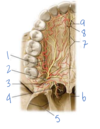
Incisive foramen
(Transmits the nasopalatine nerve and artery into the oral cavity)
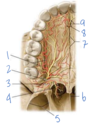
Which structure is labeled by #1?

Ary-epiglottic muscle

Which structure is labeled by #4?

Sulcus terminalis
This is the posterior boundary of the oral cavity
(Aka terminal suclcus)

Which structure is labeled by #3?

Hyoid bone

Which structure is labeled by #2?

Greater palatine foramen
Transmits the greater palatine nerve and artery

Which muscle is labeled by #5?

Lateral cricoarytenoid

Which structure is labeled by #3?

Thyroid cartilage

Which structure is labeled by #10?

Larygopharynx
(Becomes the esophagus inferior to the cricoid cartilage)

Which structure is labeled by #3?

Lesser palatine foramen
Transmits the lesser palatine nerve and artery

Which structure is labeled by #5?

Stylomandibular ligament

Which structure is labeled by #6?

Cricothyroid ligament
(Median, the membrane surrounds)
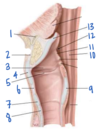
Which muscle is labeled by #6?

Thyroarytenoid

Which structure is labeled by #4?
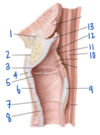
Thyroid cartilage

Which muscle is labeled by #7?
What is its action?

Thyroepiglottic muscle
Pulls the epiglottis anteriorly to help open the larynx
(Opposes the aryepiglottic muscle)

Which muscle is labeled by #2?

Transverse arytenoid

Which structure is labeled by #7?

Inferior thyroid artery

Which structure is labeled by #8?

Tracheal cartilage

Which structure is labeled by #3?
Does it have taste buds?

Fungiform papilla
Yes! Has tastebuds

Which structure is labeled by #12?

Superior laryngeal nerve, internal branch

Which structure is labeled by #9?
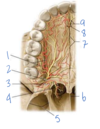
Nasopalatine nerve

Which structure is labeled by #8?

Submandibular gland

Which fold is labeled by #3?

Vocal fold (aka true vocal fold)

Which structure is labeled by #10?
(Cartilage and part)

Superior horn of thyroid cartilage

Which structure is labeled by #7?

Foramen cecum
Remnant of the thyroglossal duct, from which the thyroid gland formed

Which structure is labeled by #7?
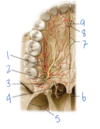
Median palatine suture
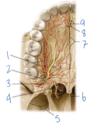
Which structure is labeled by #1?

Thyrohyoid membrane

Which structure is labeled by #2?

Pharyngeal tonsil
(Aka the adenoid)


C - mylohyoid
Which space indicated by the x has been opened up?

Laryngopharynx
- Laryngopharynx is just above and continuous with the esophagus
- It surrounds the back of the larynx
What muscle is under the mucousa indicated by X?

Posterior cricoarytenoid



